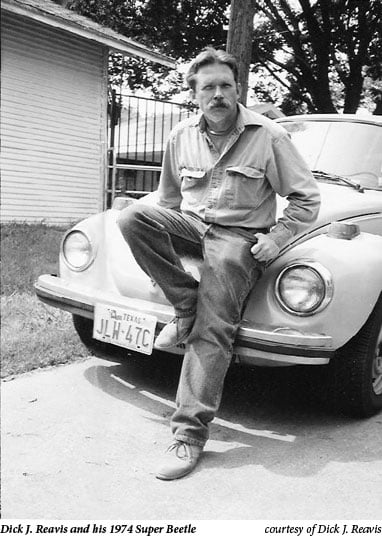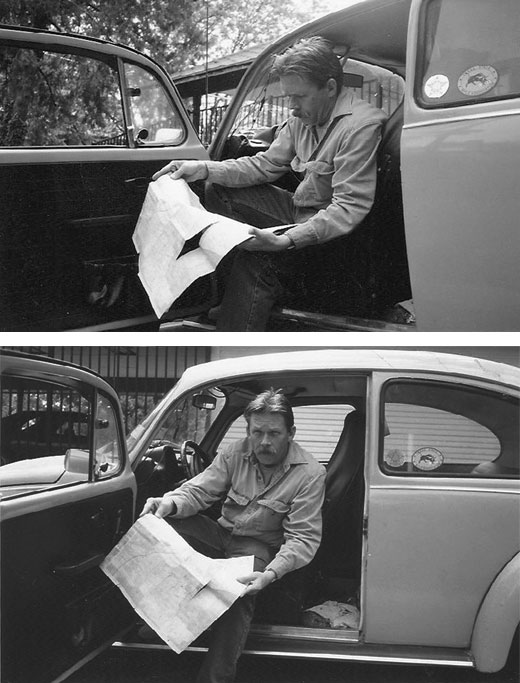Made to Last
When I twisted the ignition key on July 12, I marked an anniversary few would want to celebrate-30 years behind the wheel of a single car.
My Volkswagen Super Beetle has borne me through four countries, two careers, and about half the states on our nation’s map, a half-million miles all told. I never sold or traded the car simply because I’ve been content. Automakers may advertise improvements in myriad models every year, but they’ve yet to impress me.

I could buy a hybrid or another more energy-efficient car today, but I’m keeping mine. I do not know the ecological cost of junking an old car and building a new one, but the resources and energy that went into my Beetle are already spent.
Anybody with a Beetle, or maybe any car, can drive it for decades, as the people of Cuba have proved. Doing so is not worry-free. One must be attuned to the possibility of things going haywire, be resourceful in a pinch, and revere professional mechanics like the saints.
My 1974 Super Bee is an ordinary sedan, with dings and dents, worn seat covers replaced many times, and a fading coat of paint. A collector wouldn’t touch it. Such people prefer convertibles, or pre-1957 models with tiny, oval rear windshields, or pre-1967 models, before the Beetle was tweaked by its original designer, better known for cars that bear his name, Ferdinand Porsche.
Super Beetles were bastard cars, fathered by American safety and performance concerns. Most, like mine, have un-Beetleish curved windshields and real dashboards. They can leap from stoplights, they steer more nimbly than vintage Beetles, and they can top 80 miles per hour, except on inclines.
They failed in the marketplace because they never had air-conditioning systems worthy of the name. Mine was equipped with “260 air”: With two front windows open at 60 mph, the driver feels a breeze.
Despite the car’s drawbacks, the memory of the day I bought it is as clear in my mind as my whereabouts when I learned that JFK had been shot.
It was 1977, and I was a starving UT-Austin philosophy student who had decided to take up writing for pay. A magazine had asked me to report on an airplane loaded with marijuana that had fallen out of the sky near the small town of Big Lake, in the isolated desert country of far West Texas. Having borrowed a car for three earlier stories in faraway locales (including one for the Observer), I decided that a career as a scribbler meant buying some wheels.
Money I didn’t have. But the Super Bee, priced at only $1,800-it’s worth as much today-was within credit-card range. It appeared to be in good shape, even if its license plate indicated that the previous owner had been a rental-car firm. I signed on a dotted line and hit the road within a couple of days.
My plan was to drive from Austin to San Antonio and head west on Interstate 10. I filled the gas tank and, before stopping for lunch, realized I had a problem: The car smelled like gasoline. The fumes were annoying, even with windows open. I checked as best I could. The fuel line wasn’t leaking; the gas cap was in good shape. I couldn’t find a cause.
Neither could anyone else, again and again. Not for 21 years could I find a mechanic who could tell me why the Super Beetle stank. In the meantime, I discovered that if the fuel tank was less than three-fourths full, the car didn’t smell. I drove on short fuel rations to protect my lungs.
The trip to Big Lake was uneventful, as were hundreds of other long-distance outings, with a half-dozen exceptions, though each was a trauma for me. In 1980, a fan belt snapped, stranding me near Houston. In 1983, I loaned the car to a woman who didn’t pay heed when crossing a highway at the only traffic signal-a blinking yellow light-in the Central Texas village of Granger (population 1,000). A car traveling more than 40 mph slammed into the driver’s door, sending her to an emergency room.
I admit it: My first concern upon learning of the accident was to ask about the health of the car. Its driver was unhurt, but the Beetle was, in the argot of the insurance industry, “totaled.”
Its passenger door was folded like a leaf, the driver-side door post stooped at its middle like an arthritic old man. The front windshield was cracked, and because of the door post’s doubling, even the padded vinyl dashboard was squeezed out of form. The lower part of the car-what would be the chassis in an ordinary auto–was squished inward. A wrecker dropped the nearly dead Beetle in my front yard.
Auto insurers do not sell collision coverage on vehicles more than 20 years old, but my Super Beetle was barely nine; the company paid me some $2,200, if memory serves. For a few dollars more, a body shop put the car back on the road, after a fashion. Driving it has never felt the same. It is still a bit akimbo, and anyone with a close eye can spot Bondo patches at the point of impact.
I had the engine rebuilt twice, and not until 1998 when its generator went clunk did the car miss a workday again. After that breakdown, it didn’t fail me until 2004, when it simply slowed to a stop on I-35 between Waco and Dallas about sundown, miles from any motel. Seeing me stranded, a fellow Beetle owner stopped, towed my car to a VW specialty shop, and put me up for the night in his family’s double-wide trailer. I was the beneficiary of roadside assistance, poor-boy style.
The car started normally the next morning, and the specialty shop’s mechanic, scratching his head, sent me on my way, free of charge. But the malfunction recurred in 2005 and 2006, each time leaving me and mechanics puzzled. Last November, the owner of a Raleigh, North Carolina, shop decided that crud had collected in the car’s aging gas tank and was intermittently choking the fuel line. He replaced the tank, and I’ve had no trouble-knock on wood-since that day.
For years my Super Beetle carried me an average of about 20,000 miles a year, across every region of Texas, most of the highways in Mexico, into Guatemala in 1988, to Boston and Canada in 1990.

Along the way, I became religious about maintenance. Despite myths about unstoppable Beetles, they are, by contemporary standards, high-maintenance cars. They need oil changes at 3,000-mile intervals, valve adjustments every 6,000 miles, spark plugs at 10,000 miles, top-end replacements at 60,000 miles, and rebuilds at about 120,000 miles. To keep track of maintenance, I put a journal in its glove box. I’ve never kept a diary of any other kind.
To save trouble, I learned to replace a few parts myself. Over the years, I’ve installed four new speedometers, a half-dozen radios, turn signal flashers, interior door panels, seat covers, and carpeting. I keep a starter, an accelerator cable, a fuel pump, and a set of tools in the trunk. On a parking lot in Dallas, beside I-40 near Oklahoma City, and in tall grass on the Inner Beltline in Raleigh, passersby have either mistaken me for someone who is mechanically inclined or, more likely, have confirmed their faith that anybody can fix a Bug.
Neither my shade-tree learning nor the wisdom of more than a dozen mechanics, however, was any match for the gasoline odor with which my life in the Beetle began. In 1998, during one of those chats while picking up the car from a repair shop, Kenny Hill, an Austin Beetle mechanic since 1972, divined the cause of my venerable malfunction. The Super Beetle was designed at the dawn of antipollution improvements. A 9-inch long white plastic rectangle, about 2 inches wide, is connected to tubing from the gas tank, on the trunk side-the trunk is up front in Beetles-of the dashboard. It’s a baffle, a vapor trap. Mine was clogged. Soap and water rinsed it clean.
As the car aged and endured, I found myself thinking time and again that it had to be mortal, like me. To guard against its sudden death, 11 years ago I bought a twin, a car in reserve, a Plan B. To be sure the twin would enjoy a long life, I had a brand-new Mexican motor mounted beneath its hood, then took it to a body shop for sandblasting and a paint job.
But three years ago, contemplating a move from Austin to Raleigh, I sold the twin to a carless professor at UT-Austin who drove it until 2006, then decided to join the modern world, motorized windows and air conditioning being the price of initiation. I took the twin back, drove it across Dixie, and parked it again. Its odometer told me that its engine had run for only 26,000 miles. It might still be of some use to me, I figured.
A determined driver, I believe, can keep a Beetle running for a time yet unknown. I’ve read of an owner in California who, as part of a corporate promotion, traded in his million-mile Bug for one of the misnamed New Beetles that Volkswagen introduced in 1998.
I don’t have such grit. Last month, facing a move to a house with driveway space for only two cars-my Beetle and my wife’s 2003 Jetta-I had to make a change. I sent the Beetles for an engine swap-my half-million-mile motor, 123,000 miles past its last rebuild, for the almost-new engine in the twin.
A Palestinian-born mechanic who knew very well what he was doing bought the twin from me. When I asked what he planned to do with it, he said, “I have a son, three years old. I want him to drive it when he comes of age.”
I am past 60, and like my Super Beetle, showing signs of wear. But replacement parts for people are hard to come by. The Beetle is not as unscratched as the day it was born, but its life can be indefinitely prolonged. Barring another wreck, it’s now a fair guess that my Beetle will outlive me-and by then maybe the mechanic’s grandchild will need to buy a car, just as I did, once upon a time.
Dick J. Reavis, a Texas writer, is now an assistant professor of journalism at North Carolina State University.


